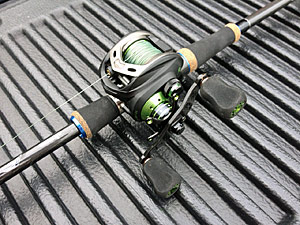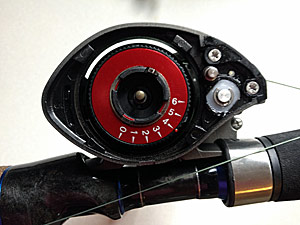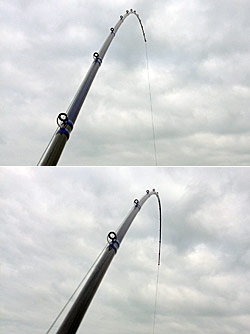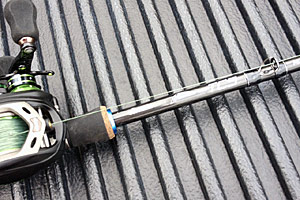
If your daddy is Roland Martin, you probably stand a good chance of getting into bass fishing, and pro angler Scott Martin has competed on the highest levels. He’s worked with Okuma to bring a series of bass rods that can stand up to the rigors of professional tournament fishing and pass muster with us picky, weekend warrior types - all without breaking the bank. I can’t imagine being a rod designer, working within those restraints, and thinking of valuable features that many top-flight tackle makers ignore. More on that later.
I picked out a monster of a stick to reviewing for you guys. It’s extra heavy power, moderately fast action rod that measures nearly eight feet long. It’s called Mat Daddy. I love the name, though it doesn’t tell the whole story of this rod. It’s not just a punching rod, to be sure. It can handle quite a few things thrown at it.

I paired the rod with an Okuma Helios (HS-273VLXa) reel, a very light, high speed 7.3:1 gear ratio reel. The reel features an aluminum frame and side plates, a clicking drag star, a carbon fiber handle, and a robust carbon fiber drag. The knobs are a light EVA material supported by two bearings, bringing the total bearing count on the reel up to nine. The reel is just as smooth as any other reel in this price range should but features a unique centrifugal braking system. Instead of tiny brake shoes or levers you push in or out, it’s a simple seven-position dial under the palm plate that allows quick adjustments while out on the water. This is super convenient, and the centrifugal brake design pairs nicely with my aggressive pitching style. There’s not much to nitpick on this reel. Perhaps a locking palm side plate or an indexed spool tension knob might be nice. Both items would add weight to the reel, and I think Okuma did very well keeping the reel close to 6 oz. to 6.3 oz. to be exact, using hardened aluminum main gear and driveshaft.
Finally, the reel is finished in a corrosion-resistant process. It’s not a bad look and feels great in my hand, not tacky or slippery. A 3-year warranty backs the reel. That’s a surprise in this “one-year limited warranty” industry. Enough about the reel, though. Suffice it to say, it works great.
As for the rod, it is a beast. I had no issue throwing Texas-rigged plastics with over 2 ounces of tungsten pegged to the hook. The rod is deceptively light, and at times I wondered if it was up to the task. I never felt outgunned, even in the nasty European milfoil and coon tail mats we get up north. The lily pads had just started to pop up, so I didn’t get a chance to hit those yet, but I’m sure this rod can handle it. The rod was so light it didn’t feel like I was using a flipping stick. It’s a far cry from the brick I’ve been using for years.

What else can the Okuma Tournament Concept TCS-C-7111XH do? Well, it’s got a moderate fast action, though the tip feels faster when casting. That big flex takes quite a bit of load before it digs in. This is one of the main things I like about the rod. It makes pitching jigs and plastics much easier but still has that “lift and separate” power in reserve for the hook set. Once under the load of a fish, all that resistance is spread across the blank, keeping the fish pinned and under control. These same characteristics are what I look for in mid-sized swimbait rods. By this, I mean two to four ounces. The long rear grip aids in making giant bomb casts that I use for delivering swimbaits to the big girls. You could probably throw bigger baits on this rod, but a bigger, round-style reel would work better here. If you want to dabble in some bigger swimbaits and get into punching, this rod will do both and do them both well. I love a multi-purpose rod, even if it has a technique-specific name.
There are some unique features in this series worth mentioning. The first guide is close to the reel. This looked like a mistake to me at first glance. However, it’s a different guide for flipping. If you’ve ever actually flipped, you’ve tangled the line on the drag star or the handle of your reel. I even have one that catches the hook holder. That deal has cost me a couple of fish over the years. When you strip line off to make another flip cast on this rod, you’re pulling from between two guides instead of between the first guide and the reel. This makes it virtually impossible to get tangled.
I don’t do a ton of flipping, but this is a very thoughtful design, no doubt the result of getting input from a real angler, like Scott Martin. Add to this, there are zero obstructions, like a poorly placed hook hanger, to get in the way. That is moved to the bottom of the blank, behind the rear split grip. It’s also the style of hanger that allows you to leave your bait rigged weedless. You snap the hook in place, and voila, you’re done.

Speaking of grips, this is a split grip design, something I don’t usually prefer for hand to hand combat in the slop, but the rear grip is not a delicate, fussy bit of cork meant only to keep your rod from sliding when you lean it up against the wall. This is a beefy fighting butt, made of hard EVA and burled cork. It’s nicely finished with color-keyed winding checks.
A quick mention of the guides – they’re not precisely micro guides, but they are much smaller than the typical guide I see on production rods. There’s a custom rod builder’s creed to use the smallest guide you can get away with and still let line and knots flow freely. This rod accomplishes that nicely. Another feature is, no doubt, integrated through real-world angler input. I used a few different lines, 65-pound braid, 30-pound fluorocarbon, and most recently, 30-pound Tuf-Line Supercast - all with and without a leader. I had no issues with knots getting stuck in the guides. It was pretty refreshing. I own some other, very pricey rods that do not perform as well.
So, how do I wrap this up? Well, take the reel at MSRP of $199.99 and the rod at $149.99, add your favorite heavy cover line, and you’re out the door with a super flipping/pitching/punching/swimbait rod for the heaviest cover you can find for well under the $400 mark. With so much in bass fishing becoming very expensive these days, this is a welcome change.
For all your hard work bringing these rods to us, thanks Okuma and Scott Martin!

